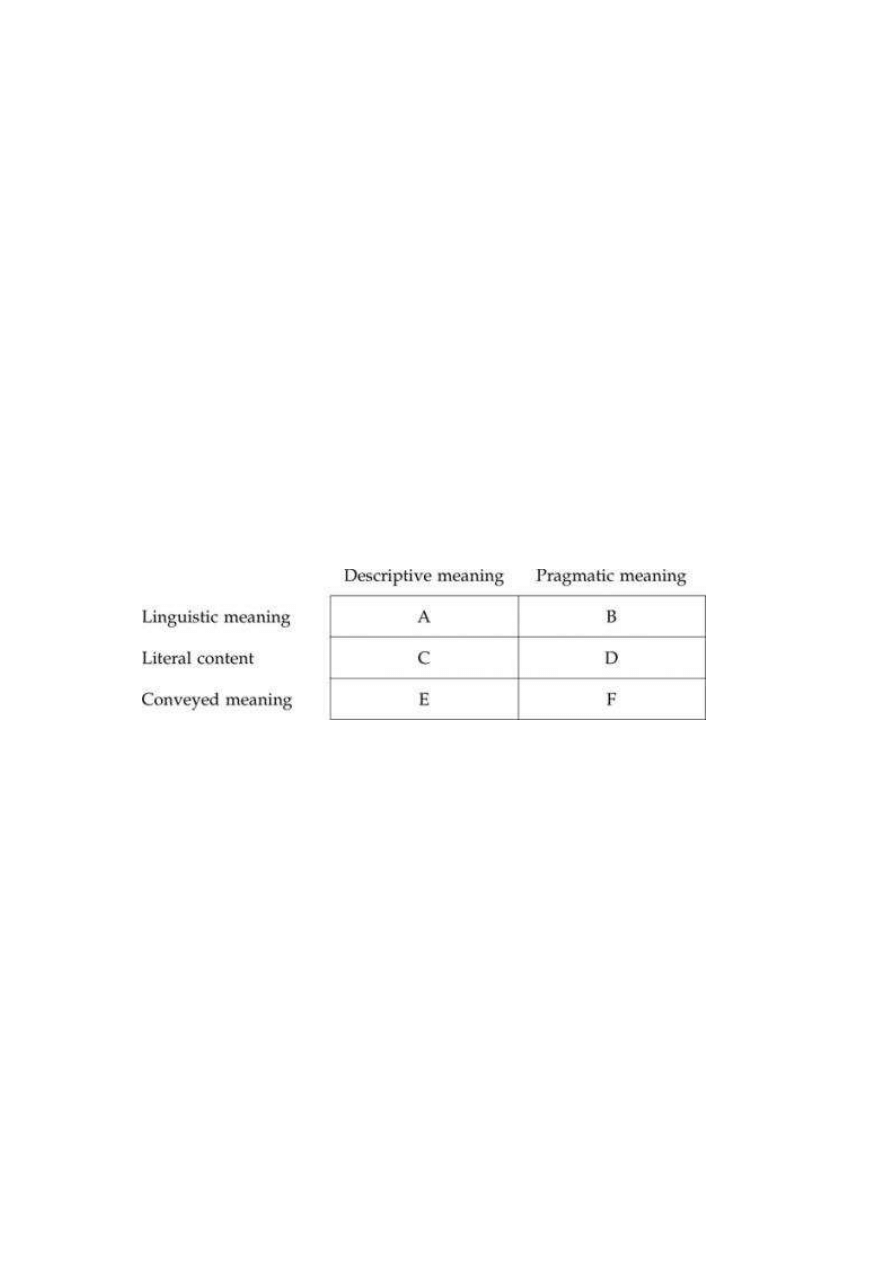
20. Pragmatics and Semantics
20. Pragmatics and Semantics
20. Pragmatics and Semantics
20. Pragmatics and Semantics
FRANÇOIS RECANATI
FRANÇOIS RECANATI
FRANÇOIS RECANATI
FRANÇOIS RECANATI
Around the middle of the twentieth century, there were two opposing camps within the analytic
philosophy of language. The first camp - IDEAL LANGUAGE PHILOSOPHY, as it was then called - was
that of the pioneers: Frege, Russell, Carnap, Tarski, etc. They were, first and foremost, logicians
studying formal languages and, through them, “language” in general. They were not originally
concerned with natural language, which they thought defective in various ways;
1
yet in the 1960s,
some of their disciples established the relevance of their methods to the detailed study of natural
language (Montague 1974, Davidson 1984). Their efforts gave rise to contemporary FORMAL
SEMANTICS, a very active discipline developed jointly by logicians, philosophers, and grammarians.
The other camp was that of so-called ORDINARY LANGUAGE PHILOSOPHERS, who thought important
features of natural language were not revealed but hidden by the logical approach initiated by Frege
and Russell. They advocated a more descriptive approach and emphasized the pragmatic nature of
natural language as opposed to, say, the formal language of
Principia Mathematica
. Their own work
2
gave rise to contemporary pragmatics, a discipline which, like formal semantics, has been developed
successfully within linguistics over the past 40 years.
Central in the ideal language tradition had been the equation of, or at least the close connection
between, the meaning of a sentence and its truth conditions. This truth-conditional approach to
meaning is perpetuated to a large extent in contemporary formal semantics. On this approach a
language is viewed as a system of rules or conventions, in virtue of which (i) certain assemblages of
symbols count as well-formed sentences, and (ii) sentences have meanings which are determined by
the meanings of their parts and the way they are put together. Meaning itself is patterned after
reference. The meaning of a simple symbol is the conventional assignment of a worldly entity to that
symbol: for example, names are assigned objects, monadic predicates are assigned properties or sets
of objects, etc. The meaning of a sentence, determined by the meanings of its constituents and the
way they are put together, is equated with its truth conditions. For example, the subject-predicate
construction is associated with a semantic rule for determining the truth conditions of a subject-
predicate sentence on the basis of the meaning assigned to the subject and that assigned to the
predicate. On this picture, knowing a language is like knowing a theory by means of which one can
deductively establish the truth conditions of any sentence of that language.
This truth-conditional approach to meaning is something that ordinary language philosophers found
quite unpalatable. According to them, reference and truth cannot be ascribed to linguistic expressions
in abstraction from their use. In vacuo, words do not refer and sentences do not have truth
conditions. Words-world relations are established through, and are indissociable from, the use of
language. It is therefore misleading to construe the meaning of a word as some worldly entity that it
represents or, more generally, as its truth-conditional contribution. The meaning of a word, insofar as
there is such a thing, should rather be equated with its use-potential or its use-conditions. In any
Theoretical Linguistics
»
Pragmatics
semantics
10.1111/b.9780631225485.2005.00022.x
Subject
Subject
Subject
Subject
Key
Key
Key
Key-
-
-
-Topics
Topics
Topics
Topics
DOI:
DOI:
DOI:
DOI:
Page 1 of 15
20. Pragmatics and Semantics : The Handbook of Pragmatics : Blackwell Reference O...
28.12.2007
http://www.blackwellreference.com/subscriber/uid=532/tocnode?id=g9780631225485...

case, what must be studied primarily is speech: the activity of saying things. Then we will be in a
position to understand language, the instrument we use in speech. Austin's theory of speech acts and
Grice's theory of speaker's meaning were both meant to provide the foundation for a theory of
language, or at least for a theory of linguistic meaning.
Despite the early antagonism I have just described, semantics (the formal study of meaning and truth
conditions) and pragmatics (the study of language in use) are now conceived of as complementary
disciplines, shedding light on different aspects of language. The heated arguments between ideal
language philosophers and ordinary language philosophers are almost forgotten. Almost, but not
totally: as we shall see, the ongoing debate about the best delimitation of the respective territories of
semantics and pragmatics betrays the persistence of two recognizable currents or approaches within
contemporary theorizing.
1 Abstracting Semantics from Pragmatics: the Carnapian
1 Abstracting Semantics from Pragmatics: the Carnapian
1 Abstracting Semantics from Pragmatics: the Carnapian
1 Abstracting Semantics from Pragmatics: the Carnapian Approach
Approach
Approach
Approach
The semantics/pragmatics distinction was first explicitly introduced by philosophers in the ideal
language tradition. According to Charles Morris, who was influenced by Peirce, the basic “semiotic”
relation is triadic: a linguistic expression is used to communicate something to someone. Within that
complex relation several dimensions can be isolated:
In terms of the three correlates (sign vehicle, designatum, interpreter) of the triadic
relation of semiosis, a number of other dyadic relations may be abstracted for study.
One may study the relations of signs to the objects to which the signs are applicable.
This relation will be called the
semantical dimension of semiosis
…. The study of this
dimension will be called
semantics
. Or the subject of study may be the relation of signs
to interpreters. This relation will be called the
pragmatical dimension of semiosis
, …
and the study of this dimension will be named
pragmatics
… The formal relation of
signs to one another … will be called the
syntactical dimension of semiosis
, … and the
study of this dimension will be named
syntactics
.
(Morris 1938: 6–7)
Carnap took up Morris's distinction and introduced an order among the three disciplines, based on
their degree of abstractness. In semantics we abstract away from more aspects of language than we
do in pragmatics, and in syntax we abstract away from more aspects than in semantics:
If in an investigation explicit reference is made to the speaker, or, to put it in more
general terms, to the user of a language, then we assign it to the field of pragmatics ….
If we abstract from the user of the language and analyze only the expressions and their
designata, we are in the field of semantics. And if, finally, we abstract from the
designata also and analyze only the relations between the expressions, we are in
(logical) syntax.
(Carnap 1942: 9)
In the theorist's reconstruction of the phenomenon, we start with the most abstract layer (syntax) and
enrich it progressively, moving from syntax to semantics and from semantics to pragmatics. Syntax
provides the input to semantics, which provides the input to pragmatics.
In what sense is it possible to separate the relation between words and the world from the use of
words? There is no doubt that the relations between words and the world hold only in virtue of the
use which is made of the words in the relevant speech community: meaning supervenes on use.
3
That
is something the logical empiricists fully admitted. Still, a distinction must be made between two
things: the conventional relations between words and what they mean, and the pragmatic basis
pragmatic basis
pragmatic basis
pragmatic basis for
those relations. Though they are rooted in, and emerge from, the use of words in actual speech
situations, the conventional relations between words and what they mean can be studied in
Page 2 of 15
20. Pragmatics and Semantics : The Handbook of Pragmatics : Blackwell Reference O...
28.12.2007
http://www.blackwellreference.com/subscriber/uid=532/tocnode?id=g9780631225485...

abstraction from use. Such an abstract study constitutes semantics. The study of the pragmatic basis
pragmatic basis
pragmatic basis
pragmatic basis
of semantics is a different study, one which belongs to pragmatics or (as Kaplan puts it)
M
ETASEMANTICS
:
The fact that a word or phrase
has
a certain meaning clearly belongs to semantics. On
the other hand, a claim about the
basis
for ascribing a certain meaning to a word or
phrase does not belong to semantics …. Perhaps, because it relates to how the language
is used, it should be categorized as part of …
pragmatics
…, or perhaps, because it is a
fact
about
semantics, as part of …
Metasemantics
.
(Kaplan 1989b: 574)
In the same Carnapian spirit Stalnaker distinguishes between D
ESCRIPTIVE
semantics and F
OUNDATIONAL
semantics:
“Descriptive semantics” … says what the semantics for the language is, without saying
what it is about the practice of using that language that explains why that semantics is
the right one. A descriptive-semantic theory assigns
semantic values
to the expressions
of the language, and explains how the semantic values of the complex expressions are a
function of the semantic values of their parts …. Foundational semantics [says] what the
facts are that give expressions their semantic values, or more generally, … what makes
it the case that the language spoken by a particular individual or community has a
particular descriptive semantics.
(Stalnaker 1997: 535)
4
The uses of linguistic forms on which their semantics depends, and which therefore constitute the
pragmatic basis for their semantics, are their past
past
past
past uses: what an expression means at time
t
in a given
community depends upon the history of its uses before
t
in the community. But of course, pragmatics
is not merely concerned with past uses. Beside the past uses of words (and constructions) that
determine the conventional meaning of a given sentence, there is another type of use that is of
primary concern to pragmatics: the current use of the sentence by the speaker who actually utters it.
That use cannot affect what the sentence conventionally means, but it determines another form of
meaning which clearly falls within the province of pragmatics: what the speaker
the speaker
the speaker
the speaker means when he says
what he says, in the context at hand. That is something that can and should be separated from the
(conventional) meaning of the sentence. To determine “what the speaker means” is to answer
questions such as: Was John's utterance intended as a piece of advice or as a threat? By saying that it
was late, did Mary mean that I should have left earlier? Like the pragmatic basis of semantics,
dimensions of language use such as illocutionary force (Austin, Searle) and conversational implicature
(Grice) can be dealt with in pragmatics without interfering with the properly semantic study of the
relations between words and their designata. So the story goes.
There are two major difficulties with this approach to the semantics/pragmatics distinction - the
Carnapian approach, as I will henceforth call it. The first one is due to the fact that the conventional
meaning of linguistic forms is not exhausted by their relation to designata. Some linguistic forms (e.g.
goodbye
, or the imperative mood) have a “pragmatic” rather than a “semantic” meaning: they have
use-conditions but do not “represent” anything and hence do not contribute to the utterance's truth
conditions. Because there are such expressions - and because arguably there are many of them and
every sentence contains at least one - we have to choose: either semantics is defined as the study of
conventional meaning, or it is defined as the study of words-world relations. We can't have it both
ways. If, sticking to Carnap's definition, we opt for the latter option, we shall have to acknowledge
that “semantics,” in the sense of Carnap, does not provide a complete (descriptive) account of the
conventional significance of linguistic forms.
The second difficulty is more devastating. It was emphasized by Yehoshua Bar-Hillel, a follower of
Carnap who wanted to apply his ideas to natural language. Carnap explicitly said he was dealing “only
Page 3 of 15
20. Pragmatics and Semantics : The Handbook of Pragmatics : Blackwell Reference O...
28.12.2007
http://www.blackwellreference.com/subscriber/uid=532/tocnode?id=g9780631225485...

with languages which contain
no expressions dependent upon extra-linguistic factors”
(Carnap
1937:168). Bar-Hillel lamented that this “restricts highly the immediate applicability” of Carnap's
views to natural languages since “the overwhelming majority of the sentences in these languages are
indexical
, i.e. dependent upon extra-linguistic factors” (Bar-Hillel 1970: 123; see Levinson, this
volume for more on indexicality). In particular, Carnap's view that words-world relations can be
studied in abstraction from use is no longer tenable once we turn to indexical languages; for the
relations between words and their designata are mediated by the (current) context of use in such
languages.
The abstraction from the pragmatic context, which is precisely the step taken from
descriptive pragmatics to descriptive semantics, is legitimate only when the pragmatic
context is (more or less) irrelevant and defensible as a tentative step only when this
context can be assumed to be irrelevant.
(Bar-Hillel 1970: 70)
Since most natural language sentences are indexical, the abstraction is illegitimate. This leaves us
with a number of (more or less equivalent) options:
1 We can make the denotation relation irreducibly triadic. Instead of saying that words denote
things, we will say that they denote things “with respect to” contexts of use.
2 We can maintain that the denotation relation is dyadic, but change the first relatum - the
denotans
, as we might say - so that it is no longer an expression-type, but a particular
occurrence of an expression, i.e. an ordered pair consisting of an expression and a context of
use.
3 We can change the second relatum of the dyadic relation: instead of pairing expressions of
the language with worldly entities denoted by them, we can pair them with functions from
contexts to denotata.
Whichever option we choose - and, again, they amount to more or less the same thing - we are no
longer doing “semantics” in Carnap's restricted sense. Rather, we are doing pragmatics, since we take
account of the context of use. Formal work on the extension of the Tarskian truth-definition to
indexical languages has thus been called (FORMAL) PRAGMATICS, following Carnap's usage (Montague
1968). As Gazdar (1979: 2–3) pointed out, a drawback of that usage is that there no longer is a
contrast between “semantics” and “pragmatics,” as far as natural language is concerned: there is no
“semantics” for natural language (and for indexical languages more generally), but only two fields of
study: syntax and pragmatics.
2
2
2
2 Meaning and Speech Acts
Meaning and Speech Acts
Meaning and Speech Acts
Meaning and Speech Acts
Can we save the semantics/pragmatics distinction for natural language? At least we can try. Following
Jerrold Katz, we can give up Carnap's definition of semantics as the study of words-world relations,
and define it instead as the study of the conventional, linguistic meaning of expression-types.
“Pragmatic phenomena,” Katz says, are “those in which knowledge of the setting or context of an
utterance plays a role in how utterances are understood”; in contrast, semantics deals with “what an
ideal speaker would know about the meaning of a sentence when no information is available about its
context” (Katz 1977: 14). This view has been, and still is, very influential. Semantics thus understood
does not (fully) determine words-world relations, but it constrains them (Katz 1975: 115–16).
Because of indexicality and related phenomena, purely linguistic knowledge is insufficient to
determine the truth conditions of an utterance. That much is commonly accepted. What semantics
assigns to expression-types, independent of context, is not a fully-fledged content but a linguistic
meaning or CHARACTER that can be formally represented as a function from contexts to contents
(Kaplan 1989a, Stalnaker 1999, part 1). Thus the meaning of the pronoun
I
is the rule that, in context,
an occurrence of
I
refers to the producer of that occurrence.
Page 4 of 15
20. Pragmatics and Semantics : The Handbook of Pragmatics : Blackwell Reference O...
28.12.2007
http://www.blackwellreference.com/subscriber/uid=532/tocnode?id=g9780631225485...

Insofar as their character or linguistic meaning can be described as a rule of use, indexical
expressions are not as different as we may have thought from those expressions whose meaning is
purely “pragmatic.” What is the meaning of, say, the imperative mood? Arguably, the sentences “You
will go to the store tomorrow at 8,” “Will you go to the store tomorrow at 8?”, and “Go to the store
tomorrow at 8” all have the same descriptive content. The difference between them is pragmatic: it
relates to the type of illocutionary act performed by the utterance. Thus the imperative mood
indicates that the speaker, in uttering the sentence, performs an illocutionary act of a DIRECTIVE type.
To account for this non-truth-conditional indication we can posit a rule to the effect that the
imperative mood is to be used only if one is performing a directive type of illocutionary act. This rule
gives conditions of
conditions of
conditions of
conditions of use
use
use
use for the imperative mood. By virtue of this rule, a particular token of the
imperative mood in an utterance
u
“indicates” that a directive type of speech act is being performed
by
u
. This reflexive indication conveyed by the token follows from the conditions of use which govern
the type. The same sort of USE-CONDITIONAL analysis can be provided for, for example, discourse
particles such as
well, still, after all, anyway, therefore, alas, oh
, and so forth, whose meaning is
pragmatic rather than truth-conditional (see Blakemore, this volume).
There still is a difference between indexical expressions and fully pragmatic expressions such as the
imperative mood. In both cases the meaning of the expression-type is best construed as a rule of use.
Thus
I
is to be used to refer to the speaker, just as the imperative mood is to be used to perform a
certain type of speech act. By virtue of the rule in question, a use
u
of
I
reflexively indicates that it
refers to the speaker of
u
, just as a use
u
of the imperative mood indicates that the utterer of
u
is
performing a directive type of speech act. But in the case of
I
the token does not merely convey that
reflexive indication: it also contributes its referent to the utterance's truth-conditional content. In
contrast, the imperative mood does not contribute to the truth-conditional (or, more generally,
descriptive) content of the utterances in which it occurs. In general, pragmatic expressions do not
contribute to the determination of the content of the utterance, but to the determination of its force
or of other aspects of utterance meaning external to descriptive content.
It turns out that there are (at least) three different types of expression. Some expressions have a
purely denotative meaning: their meaning is a worldly entity that they denote. For example,
square
denotes the property of being square. Other expressions, such as the imperative mood, have a purely
pragmatic meaning. They have conditions of use but make no contribution to content. Finally, there
are expressions which, like indexicals, have conditions of use but contribute to truth conditions
nevertheless. (The expression-type has conditions of use; the expression-token contributes to truth
conditions.)
This diversity can be overcome and some unification achieved. First, we can generalize the
content/character distinction even to non-indexical expressions like
square
. We can say that every
linguistic expression is endowed with a character that contextually determines its content. Non-
indexical expressions will be handled as a particular case: the case in which the character is “stable”
and determines the same content in every context. Second, every expression, whether or not it
contributes to truth-conditional content, can be construed as doing basically the same thing -
namely, helping the hearer to understand which speech act is performed by an utterance of the
sentence. A speech act typically consists of two major components: a content and a force (Searle
1969; see also Sadock, this volume). Some elements in the sentence indicate the force of the speech
act which the sentence can be used to perform, while other elements give indications concerning the
content of the speech act. Unification of the two sorts of elements is therefore achieved by equating
the meaning of a sentence with its speech act potential.
On the view we end up with - the speech-act theoretic view - semantics deals with the conventional
meaning of expressions, the conventional meaning of expressions is their contribution to the
meaning of the sentences in which they occur, and the meaning of sentences is their speech act
potential. Pragmatics studies speech acts, and semantics maps sentences onto the type of speech act
they are designed to perform. It follows that there are two basic disciplines in the study of language:
syntax and pragmatics. Semantics connects them by assigning speech act potentials to well-formed
sentences, hence it presupposes both syntax and pragmatics. In contrast to the Carnapian view,
according to which semantics presupposes only syntax, on the speech-act theoretic view semantics is
not autonomous with respect to pragmatics:
Page 5 of 15
20. Pragmatics and Semantics : The Handbook of Pragmatics : Blackwell Reference O...
28.12.2007
http://www.blackwellreference.com/subscriber/uid=532/tocnode?id=g9780631225485...

There is no way to account for the meaning of a sentence without considering its role in
communication, since the two are essentially connected … Syntax can be studied as a
formal system independent of its use …, but as soon as we attempt to account for
meaning, for semantic competence, such a purely formalistic approach breaks down,
because it cannot account for the fact that semantic competence is mostly a matter of
knowing how to talk, i.e. how to perform speech acts.
(Searle, “Chomsky's Revolution in Linguistics,” cited in Katz 1977: 26)
There are other possible views, however. We can construe semantics as an autonomous discipline that
maps sentences to the type of thought they express or the type of state of affairs they describe. That
mapping is independent from the fact that sentences are used to perform speech acts. Note that
communication is not the only possible use we can make of language; we can also use language in
reasoning, for example. Be that as it may, whoever utters a given sentence - for whatever purpose -
expresses a thought or describes a state of affairs, in virtue of the semantics of the sentence (and the
context).
5
Let us assume that the sentence is uttered in a situation of communication. Depending on
the audience-directed intentions that motivate the overt expression of the thought or the overt
description of a state of affairs in that situation, different speech acts will be performed. Those
audience-directed intentions determine the force of the speech act, while the thought expressed by
the sentence or the state of affairs it describes determines its content. In this framework, pragmatic
indicators like the imperative mood can be construed as conventional ways of making the relevant
audience-directed intentions manifest. Their meaning, in contrast to the meaning of ordinary words
like
square
, will be inseparable from the speech act the sentence can be used to perform. It is
therefore not the overall meaning of the sentence that must be equated with its speech act potential.
The major part of linguistic meaning maps linguistic forms to conceptual representations in the mind
or to things in the world in total independence from communication. It is only a small subset of
linguistic expressions, namely the pragmatic indicators and other expressions (including indexicals)
endowed with use-conditional meaning, whose semantics is essentially connected with their
communicative function.
Whichever theory we accept, semantics (the study of linguistic meaning) and pragmatics (the study of
language use) overlap to some extent (see
figure 20.1
). That overlap is limited for the theories of the
second type: the meaning of a restricted class of expressions consists in conditions of use and
therefore must be dealt with both in the theory of use and the theory of meaning. According to the
first type of theory, there is more than partial overlap: every expression has a use-conditional
meaning. Since, for that type of theory, the meaning of a sentence is its speech act potential,
semantics is best construed as a subpart of speech act theory.
Figure 20.1 Diagram showing the overlap of semantics and
Figure 20.1 Diagram showing the overlap of semantics and
Figure 20.1 Diagram showing the overlap of semantics and
Figure 20.1 Diagram showing the overlap of semantics and pragmatics
pragmatics
pragmatics
pragmatics
Page 6 of 15
20. Pragmatics and Semantics : The Handbook of Pragmatics : Blackwell Reference O...
28.12.2007
http://www.blackwellreference.com/subscriber/uid=532/tocnode?id=g9780631225485...

3 Literal Meaning vs. Speaker's Meaning
3 Literal Meaning vs. Speaker's Meaning
3 Literal Meaning vs. Speaker's Meaning
3 Literal Meaning vs. Speaker's Meaning
Let us take stock. The view discussed in section 1 was based on the following assumptions:
(i) semantics and pragmatics are two complementary, non-overlapping disciplines;
(ii) pragmatics deals with the use of language;
(iii) semantics deals with content and truth conditions.
Since words-world relations in natural language (hence content and truth conditions) cannot be
studied in abstraction from use, those assumptions form an inconsistent triad - or so it seems.
Semantics cannot be legitimately contrasted with pragmatics, defined as the theory of use, if
semantics itself is defined as the study of words-world relations.
In section 2 we entertained the possibility of giving up (iii). Following Katz, we can retreat to the view
that semantics deals with the conventional meaning of expression-types (rather than with content and
truth conditions). But we have just seen that the meaning of at least some expressions is best
construed as a convention governing their use. It follows that the theory of meaning and the theory of
use are inextricably intertwined, in a manner that seems hardly compatible with (i). Be that as it may,
most semanticists are reluctant to give up (iii). For both philosophical and technical reasons, they
think the denotation relation must be the cornerstone of a theory of meaning. As David Lewis wrote in
a famous passage, “semantics with no treatment of truth conditions is not semantics” (Lewis 1972:
169). I will return to that point below (section 4).
An attempt can be made to save the triad, by focusing on the distinction between
LITERAL
MEANING
and
SPEAKER
'
S
MEANING
. What a sentence literally means is determined by the rules of the language - those
rules that the semanticist attempts to capture. But what the speaker means by his utterance is not
determined by rules. As Grice emphasized, speaker's meaning is a matter of intentions: what
someone means is what he or she overtly intends (or, as Grice says, “M-intends”) to get across
through his or her utterance. Communication succeeds when the M-intentions of the speaker are
recognized by the hearer.
This suggests that two distinct and radically different processes are jointly involved in the
interpretation of linguistic utterances. The process of
SEMANTIC
INTERPRETATION
is specifically linguistic.
It consists in applying the tacit theory that speaker-hearers are said to possess, and that formal
semantics tries to make explicit, to the sentence undergoing interpretation. By applying the theory,
one can deductively establish the truth conditions of any sentence of the language. To do so, it is
argued, one does not need to take the speaker's beliefs and intentions into account: one has simply to
apply the rules. In contrast, the type of competence that underlies the process of
PRAGMATIC
INTERPRETATION
is not specifically linguistic. Pragmatic interpretation is involved in the understanding
of human action in general. When someone acts, whether linguistically or otherwise, there is a reason
why he does what he does. To provide an interpretation for the action is to find that reason, that is, to
ascribe to the agent a particular intention in terms of which we can make sense of the action.
Pragmatic interpretation thus construed is characterized by the following three properties:
•
CHARITY
. Pragmatic interpretation is possible only if we presuppose that the agent is rational.
To interpret an action, we have to make hypotheses concerning the agent' s beliefs and
desires, hypotheses in virtue of which it can be deemed rational for the agent to behave as she
does.
•
NON
-
MONOTONICITY
. Pragmatic interpretation is defeasible. The best explanation we can offer
for an action given the available evidence can always be overridden if enough new evidence is
adduced to account for the subject's behavior.
•
HOLISM
. Because of its defeasibility, there is no limit to the amount of contextual information
that can in principle affect pragmatic interpretation. Any piece of information can turn out to
be relevant and influence the outcome of pragmatic interpretation.
Page 7 of 15
20. Pragmatics and Semantics : The Handbook of Pragmatics : Blackwell Reference O...
28.12.2007
http://www.blackwellreference.com/subscriber/uid=532/tocnode?id=g9780631225485...

The three features go together. Jointly they constitute what we might call the
HERMENEUTIC
character of
pragmatic interpretation. It strikingly contrasts with the algorithmic, mechanical character of semantic
interpretation.
It is important to realize that, on this view (which I will shortly criticize), semantic competence
involves more than the ability to determine the context-independent meaning of any well-formed
expression in the language. It also involves the ability to assign values to indexical expressions in
context. Those assignments are themselves determined by linguistic rules, which linguistic rules
constitute the context-independent meaning of indexical expressions. In virtue of its linguistic
meaning, an indexical expression like
I
tells you three things: (i) that it needs to be contextually
assigned a value; (ii) which aspect of the situation of utterance is relevant to determining that value;
and (iii) how the value of the indexical can be calculated once the relevant feature of the context has
been identified. If one adds to one's knowledge of the language a minimal knowledge of the situation
of utterance - the sort of knowledge which is available to speech participants qua speech participants
- one is in a position to assign contextual values to indexicals, hence to determine the truth
conditions of the utterance.
From what has been said, it follows that the context of use plays a role both in semantic and in
pragmatic interpretation. But it plays very different roles in each, and it can even be denied that there
is a single notion of “context” corresponding to the two roles. According to Kent Bach, there are two
notions of context: a narrow and a broad one, corresponding to semantic and pragmatic
interpretation respectively.
Wide context concerns any contextual information relevant to determining the speaker's
intention and to the successful and felicitous performance of the speech act … Narrow
context concerns information specifically relevant to determining the semantic values of
[indexicals] … Narrow context is semantic, wide context pragmatic.
6
In contrast to the wide context, which is virtually limitless in the sense that any piece of information
can affect pragmatic interpretation, the narrow context is a small package of factors involving only
very limited aspects of the actual situation of utterance: who speaks, when, where, to whom, and so
forth. It comes into play only to help determine the reference of those few expressions whose
reference is not fixed directly by the rules of the language but is fixed by them only “relative to
context.” And it does so in the algorithmic and non-hermeneutical manner which is characteristic of
semantic interpretation as opposed to pragmatic interpretation. The narrow context determines, say,
that
I
refers to John when John says
I
quite irrespective of John's beliefs and intentions. As Barwise and
Perry write, “even if I am fully convinced that I am Napoleon, my use of T designates me, not him.
Similarly, I may be fully convinced that it is 1789, but it does not make my use of ‘now’ about a time
in 1789” (Barwise and Perry 1983: 148).
The view I have just described is very widespread and deserves to be called the Standard Picture (SP).
It enables the theorist to maintain the three assumptions listed at the beginning of this section.
Semantics and pragmatics each has its own field of study. Semantics deals with literal meaning and
truth conditions; pragmatics deals with speech acts and speaker's meaning. To be sure, the “context”
plays a role in semantic interpretation, because of the context-dependence of truth-conditional
content. But that is not sufficient to threaten assumption (i). Because of context-dependence,
semantics cannot deal merely with sentence-types: it must deal with OCCURRENCES or sentences-in-
context. But this, as Kaplan writes, “is not the same as the notion, from the theory of speech acts, of
an utterance of an expression by the agent of a context” (Kaplan 1989b: 584):
An occurrence requires no utterance. Utterances take time, and are produced one at a
time; this will not do for the analysis of validity. By the time an agent finished uttering a
very, very long true premise and began uttering the conclusion, the premise may have
gone false … Also, there are sentences which express a truth in certain contexts, but
not if uttered. For example, “I say nothing”. Logic and semantics are concerned not with
the vagaries of actions, but with the verities of meanings.
Page 8 of 15
20. Pragmatics and Semantics : The Handbook of Pragmatics : Blackwell Reference O...
28.12.2007
http://www.blackwellreference.com/subscriber/uid=532/tocnode?id=g9780631225485...

(Kaplan 1989b: 584–5)
Moreover, as we have seen, the context which is appealed to in semantic interpretation differs from
the “wide” context which features in pragmatic interpretation. Semantics deals with occurrences,
narrow contexts, and literal meaning; pragmatics deals with utterances, wide contexts, and speaker's
meaning. Appearances notwithstanding, the two types of study do not overlap.
4 Semantic Underdetermination
4 Semantic Underdetermination
4 Semantic Underdetermination
4 Semantic Underdetermination
Even though it is the dominant view, SP has come under sustained attack during the last 15 years, and
an alternative picture has been put forward: TRUTH-CONDITIONAL PRAGMATICS (TCP). From SP, TCP
inherits the idea that two different sorts of competence are jointly at work in interlocution: a properly
linguistic competence in virtue of which we access the meaning of the sentence, and a more general-
purpose competence in virtue of which we can make sense of the utterance much as we make sense
of a non-linguistic action. What TCP rejects is the claim that semantic interpretation can deliver
something as determinate as a truth-evaluable proposition. As against SP, TCP holds that full-blown
pragmatic interpretation is needed to determine an utterance's truth conditions.
Recall that, on the Standard Picture, the reference of indexicals is determined automatically on the
basis of a linguistic rule, without taking the speaker's beliefs and intentions into consideration. Now
this may be true of some of the expressions that Kaplan (1989a) classifies as PURE INDEXICALS (e.g.
I,
now, here
) but it is certainly not true of those which he calls DEMONSTRATIVES (e.g.
he, she, this,
that
). The reference of a demonstrative cannot be determined by a rule like the rule that
I
refers to the
speaker. It is generally assumed that there is such a rule, namely the rule that the demonstrative
refers to the object which happens to be demonstrated or which happens to be the most salient, in
the context at hand. But the notions of “demonstration” and “salience” are pragmatic notions in
disguise. They cannot be cashed out in terms merely of the narrow context. Ultimately, a
demonstrative refers to what the speaker
what the speaker
what the speaker
what the speaker who uses it refers to by using it
who uses it refers to by using it
who uses it refers to by using it
who uses it refers to by using it.
To be sure, one can make that into a semantic rule. One can say that the character of a demonstrative
is the rule that it refers to what the speaker intends to refer to. As a result, one will incorporate a
sequence of “speaker's intended referents” into the narrow context, in such a way that the
n
th
demonstrative in the sentence will refer to the
n
th
member of the sequence. Formally that is fine, but
philosophically it is clear that one is cheating. We pretend that we can manage with a limited, narrow
narrow
narrow
narrow
notion of context of the sort we need for handling pure indexicals, while in fact we can only
determine the speaker's intended referent (hence the narrow context relevant to the interpretation of
the utterance) by resorting to pragmatic interpretation and relying on the wide
wide
wide
wide context.
We encounter the same problem even with expressions like
here
and
now
, which Kaplan classifies as
pure
pure
pure
pure indexicals (as opposed to demonstratives). Their semantic value is said to be the time or place of
the context respectively. But what counts as the time and place of the context? How inclusive must the
time or place in question be? It depends on what the speaker means, hence, again, on the wide
context. We can maintain that the character of
here
and
now
is the rule that the expression refers to
“the” time or “the” place of the context - a rule that automatically determines a content, given a
(narrow) context in which the time and place parameters are given specific values; but then we have
to let a pragmatic process take place to fix the values in question, that is, to determine
which
narrow
context, among indefinitely many candidates compatible with the facts of the utterance, serves as
argument to the character function. On the resulting view, the (narrow) context with respect to which
an utterance is interpreted is not given, not determined automatically by objective facts like where
and when the utterance takes place, but it is determined by the speaker's intention and the wide
context. Again we reach the conclusion that, formal tricks notwithstanding, pragmatic interpretation
has a role to play in determining the content of the utterance.
The alleged automaticity of content-determination and its independence from pragmatic
considerations is an illusion due to an excessive concern with a subclass of “pure indexicals,” namely
words such as
I, today
, etc. But they are only a special case - the end of a spectrum. In most cases the
reference of a context-sensitive expression is determined on a pragmatic basis. That is true not only
of standard indexical expressions, but also of many constructions involving something like a free
Page 9 of 15
20. Pragmatics and Semantics : The Handbook of Pragmatics : Blackwell Reference O...
28.12.2007
http://www.blackwellreference.com/subscriber/uid=532/tocnode?id=g9780631225485...

variable. For example, a possessive phrase such as
John's car
arguably means something like “the car
that bears relation
R
to John”. The free variable
R
must be contextually assigned a particular value; but
that value is not determined by a rule and it is not a function of a particular aspect of the narrow
context. What a given occurrence of the phrase
John's car
means ultimately depends upon what the
speaker who utters it means. It therefore depends upon the wide context. That dependence upon the
wide context is a characteristic feature of semantically indeterminate expressions, which are pervasive
in natural language. Their semantic value varies from occurrence to occurrence, yet it varies not as a
function of some objective feature of the narrow context but as a function of what the speaker means
what the speaker means
what the speaker means
what the speaker means.
It follows that semantic interpretation by itself cannot determine what is said by a sentence containing
such an expression: for the semantic value of the expression - its own contribution to what is said -
is a matter of speaker's meaning, and can only be determined by pragmatic interpretation.
Once again, we find that semantics by itself cannot determine truth conditions. Content and truth
conditions are, to a large extent, a matter of pragmatics. That is the gist of TCP. Consequently, most
advocates of TCP hold a view of semantics which is reminiscent of that put forward by Katz. According
to Sperber and Wilson (1986a) and other relevance theorists (see Wilson and Sperber, this volume;
Carston, this volume), semantics associates sentences with semantic representations which are highly
schematic and fall short of determining truth-conditional content. Those semantic representations,
which they call
LOGICAL
FORMS
, are transformed into complete, truth-evaluable representations (which
they call
PROPOSITIONAL
FORMS
) through inferential processes characteristic of pragmatic interpretation.
(Chomsky holds a similar view, based on a distinction between the logical form of a sentence,
determined by the grammar, and a richer semantic representation associated with that sentence as a
result, in part, of pragmatic interpretation. See Chomsky 1976: 305–6.)
This view of semantics is one most semanticists dislike. In contrast to Katz, leading semanticists like
Lewis, Cresswell, and Davidson hold that “interpreting” a representation is NOT a matter of
associating it with another type of representation (whether mental or linguistic). “Semantic
interpretation [thus construed] amounts merely to a translation algorithm”; it is “at best a substitute
for real semantics” (Lewis 1972: 169). Real semantics maps symbols to worldly entities - things that
the representations may be said to represent.
Relevance theorists apparently bite the bullet. They accept that linguistic semantics (which maps
sentences to abstract representations serving as linguistic meanings) is not real semantics in the
sense of the model-theoretic tradition descended from Frege, Tarski, Carnap, and others. But, they
argue, there is no way to do real semantics directly on natural language sentences. Real semantics
comes into play only after “linguistic semantics” has mapped the sentence onto some abstract and
incomplete representation which pragmatics can complete and enrich into a fully-fledged
propositional form. It is that propositional form which eventually undergoes truth-conditional
interpretation. As Carston writes,
Since we are distinguishing natural language sentences and the propositional forms [i.e.
the thoughts] they may be used to express as two different kinds of entity, we might
consider the semantics of each individually. Speakers and hearers map incoming
linguistic stimuli onto conceptual representations (logical forms), plausibly viewed
themselves as formulas in a (mental) language. The language ability - knowing English -
according to this view, is then precisely what Lewis and others have derided …: it is the
ability to map linguistic forms onto logical forms … In theory this ability could exist
without the further capacities involved in matching these with conditions in the world. A
computer might be programmed so as to perform perfectly correct translations from
English into a logical language without, as Lewis and Searle have said, knowing the first
thing about the meaning (= truth conditions) of the English sentence. Distinguishing
two kinds of semantics in this way - a translational kind and the truth-conditional -
shows … that the semantic representation of one language may be a syntactic
representation in another, though the chain must end somewhere with formulas related
to situations and states of the world or possible worlds.
(Carston 1988: 176–7)
Page 10 of 15
20. Pragmatics and Semantics : The Handbook of Pragmatics : Blackwell Reference...
28.12.2007
http://www.blackwellreference.com/subscriber/uid=532/tocnode?id=g9780631225485...

There was a time when practitioners of model-theoretic semantics themselves thought their
apparatus could not be transplanted from artificial to natural languages. Tarski thought so, for
example. Following Davidson, Montague, and others, it has become widely accepted that Tarskian
methods are applicable to natural languages after all. Now it seems that pragmaticists are saying that
that conclusion was premature: truth-conditional semantics, they hold, is applicable to the language
of thought, but not, or not directly, to natural language sentences. Because of context-sensitivity,
there must be an intermediary step involving both translational semantics and pragmatic
interpretation before a given natural language sentence can be provided with a truth-conditional
interpretation. “Linguistic semantics” and pragmatics together map a natural language sentence onto
a mental representation which model-theoretic semantics can then (and only then) map to a state of
affairs in the world.
The general picture of the comprehension process put forward by relevance theorists may well be
right. But it is a mistake to suggest that the model-theoretic approach to natural language semantics
and TCP are incompatible. Even if, following Lewis and Davidson, one rejects translational semantics
in favor of “direct” truth-conditional semantics, one can still accept that pragmatic interpretation has
a crucial role to play in determining truth conditions.
First, it should be noted that referential semantics, as Lewis calls the model-theoretic approach, can
and must accommodate the phenomenon of context-sensitivity. Because of that phenomenon, we
cannot straightforwardly equate the meaning of a sentence with its truth conditions: we must retreat
to the weaker view that sentence meaning determines
determines
determines
determines truth conditions. As Lewis writes, “A meaning
for a sentence is something that determines the conditions under which the sentence is true or
false” (Lewis 1972: 173). That determination is relative to
relative to
relative to
relative to various contextual factors. Hence the
meaning of a sentence can be represented as a function from context to truth conditions. Since
meaning is characterized in terms of reference and truth, this still counts as referential semantics.
In this framework, the role pragmatic interpretation plays in the determination of truth-conditional
content can be handled at the level of the contextual factors on which that determination depends.
For example, if the truth conditions of an utterance depend upon who the speaker means by
she
, then
the speaker's intended referent can be considered as one of the contextual factors in question. To be
sure, the speaker's referent can be determined only through pragmatic interpretation. That fact, as we
have seen, is incompatible with the Standard Picture, according to which semantic interpretation by
itself assigns truth conditions to sentences. But it is not incompatible with referential semantics per
se. From the role played by pragmatic interpretation in fixing truth conditions, all that follows is that
truth
truth
truth
truth-
-
-
-conditional semantics has to take input from pragmatics
conditional semantics has to take input from pragmatics
conditional semantics has to take input from pragmatics
conditional semantics has to take input from pragmatics. That is incompatible with the claim
that semantics is autonomous with respect to pragmatics (as syntax is with respect to semantics). But
this claim is not essential to referential semantics. Several theorists in the model-theoretic tradition
have rejected it explicitly (see e.g. Gazdar 1979: 164–8 for an early statement). As Levinson (2000a:
242) writes, “there is every reason to try and reconstrue the interaction between semantics and
pragmatics as the intimate interlocking of distinct processes, rather than, as traditionally, in terms of
the output of one being the input to the other.”
I conclude that referential semantics and TCP are compatible. We can maintain both that semantics
determines truth conditions and that, in order to do so, it needs input from pragmatics. The two
claims are compatible provided we give up the assumption that semantics is autonomous with respect
to pragmatics. If, for some reason, we insist on keeping that assumption, then we must indeed retreat
to a translational view of semantics. Thus Carston (1988: 176) writes: “Linguistic semantics IS
autonomous with respect to pragmatics; it provides the input to pragmatic processes and the two
together make propositional forms which are the input to a truth-conditional semantics.” But this
view, which distinguishes two kinds of semantics, is not forced upon us by the simple fact that we
accept TCP. We need to posit a level of translational
translational
translational
translational semantics distinct from and additional to
standard truth-conditional semantics only if, following Katz, we insist that linguistic semantics must
be autonomous with respect to pragmatics.
5 Varieties of
5 Varieties of
5 Varieties of
5 Varieties of Meaning
Meaning
Meaning
Meaning
Meaning comes in many varieties. Some of these varieties are said to belong to the field of semantics,
others to the field of pragmatics. What is the principle of the distinction? Where does the boundary
Page 11 of 15
20. Pragmatics and Semantics : The Handbook of Pragmatics : Blackwell Reference...
28.12.2007
http://www.blackwellreference.com/subscriber/uid=532/tocnode?id=g9780631225485...

lie? Before addressing these questions, let us review the evidence by actually looking at the varieties
of meaning and what is said about them in the literature on the semantics/pragmatics distinction.
As we have seen, there are several levels
levels
levels
levels of meaning. When an utterance is made, the sentence-type
that is uttered possesses a linguistic meaning (level 1). More often than not, that meaning is not a
complete content: to get a complete content, one must resolve indeterminacies, assign values to
indexical expressions, etc. The richer meaning thus determined is the literal content of the
occurrence, which depends not merely upon the conventional significance of the expression-type, but
also on features of the context of use (level 2). At level 3, we find aspects of meaning that are not part
of the literal content of the utterance. Those aspects of meaning are not aspects of what is said.
Rather, the speaker manages to communicate them indirectly, BY saying what she says.
Conversational implicatures and indirect speech acts fall into that category. This division into three
levels - linguistic meaning, literal content, and conveyed meaning - is incomplete and very rough, but
it will do for my present purposes.
Besides the division into levels, there is a further distinction between two types of meaning:
descriptive meaning and pragmatic meaning. Both types of meaning can be discerned at the three
levels listed above. At the first level, descriptive meaning maps linguistic forms to what they
represent; pragmatic meaning relates to their use and constrains the context in which they can occur.
At the next level, this corresponds to the distinction between the descriptive content of the utterance
(the state of affairs it represents) and its role or function in the discourse. Something similar can often
be found at the third level, since what is conveyed may itself be analyzable into force and content.
This gives us six aspects of meaning, corresponding to the six cells in (1):
(1)
In what follows I will briefly consider the six aspects in turn. Of each aspect I will ask whether,
according to the literature, it pertains to semantics, to pragmatics, or to both.
In cell A, we find the descriptive meaning of expression-types (e.g. the meaning of words like
square
or
table
). That is clearly and unambiguously part of the domain of semantics. No one will disagree
here. When we turn to cell B things are less clear. The pragmatic meaning of indicators pertains to
semantics insofar as semantics deals with linguistic meaning. Many people hold that view. Some
theorists insist on excluding that sort of meaning from semantics, because it is not relevant to truth
conditions (Gazdar 1979). Even if one is convinced that semantics with no treatment of truth
conditions is not semantics, however, it seems a bit excessive and unnatural to hold that semantics
deals only with truth conditions. Still, the meaning of pragmatic indicators is best handled in terms of
conditions of use or in terms of constraints on the context, and that provides us with a positive
reason for considering that it belongs to the field of pragmatics. This does not necessarily mean that
it does not belong to semantics, however. It is certainly possible to consider that the meaning of
pragmatic indicators is of concern to both semantics and pragmatics (section 2).
Let us now consider the aspect of meaning that corresponds to cell D. In context, the meaning of
pragmatic indicators is fleshed out and made more specific. For example, an utterance of an
imperative sentence will be understood specifically as a request or as a piece of advice. Or consider
the word
but
, which carries what Grice (1967) calls a CONVENTIONAL IMPLICATURE, that is, a non-
truth-conditional component of meaning conventionally associated with the expression. The word
but
in the sentence type “He is rich, but I like beards” signals an argumentative contrast between “he is
Page 12 of 15
20. Pragmatics and Semantics : The Handbook of Pragmatics : Blackwell Reference...
28.12.2007
http://www.blackwellreference.com/subscriber/uid=532/tocnode?id=g9780631225485...

rich” and “I like beards,” but that contrast cannot be specified
in vacuo
. To understand the contrast,
we must know which conclusion the antecedent “he is rich” is used to argue for, in the context at
hand. According to Ducrot (1972: 128–31),
but
indicates that the following conditions are
contextually satisfied: the first clause
p
supports a certain conclusion
r
, while the second clause
q
provides a stronger argument against that very same conclusion. (As a result, the whole conjunction
argues against
r
.) Just as one must assign a referent to the third-person pronoun in order to
understand the literal content of “he is rich,” in order to grasp the literal content of the conjunction
“He is rich but I like beards” one must assign a value to the free variable
r
which is part and parcel of
the meaning of
but
, e.g. “… so I won't marry him.” Yet the indication thus fleshed out remains
external to the utterance's truth-conditional content: it belongs only to the “pragmatic” side of literal
content. Because that is so, and also because the specific indication conveyed by
but
heavily depends
upon the context (which provides a value for the free variable), it does not feel natural to say that that
aspect of the interpretation of the utterance is semantic. Many theorists hold that the conventional
meaning of
but
(cell B) belongs to semantics (as well as, perhaps, to pragmatics), but many fewer
would be willing to say the same thing concerning the specific suggestion conveyed by a
contextualized use of
but
. In the case of the imperative sentence which, in context, may be used
either to request or to advise, the contrast is even more dramatic. As far as I can tell, no one is willing
to say that the specific illocutionary force of the utterance belongs to semantics, even among those
who consider the meaning of moods (cell B) as semantic.
What about the descriptive side of literal content (cell C)? That, as we have seen, belongs both to
semantics and to pragmatics. Pragmatics determines the value of indexicals and other free variables,
and semantics, with that input, determines truth-conditional content. Most theorists think the literal
truth conditions of an utterance fall on the semantic side of the divide, however, even though
pragmatics plays a crucial role. The reason for that asymmetry is that it is the words themselves
which, in virtue of their conventional significance, make it necessary to appeal to context in order to
assign a semantic value to the indexicals and other free variables. In interpreting indexical sentences,
we go beyond what the conventions of the language give us, but that step beyond is still governed by
the conventions of the language. In that sense pragmatics is subordinated to semantics in the
determination of truth-conditional content.
That conclusion can be disputed, however. According to TCP, the pragmatic processes that play a role
in the determination of literal content (PRIMARY pragmatic processes, as I call them) fall into two
categories. The determination of the reference of indexicals and, more generally, the determination of
the content of context-sensitive expressions is a typical BOTTOM-UP PROCESS, i.e. a process
triggered (and made obligatory) by a linguistic expression in the sentence itself. But there are other
primary pragmatic processes that are not bottom-up. Far from being triggered by an expression in
the sentence, they take place for purely pragmatic reasons. To give a standard example, suppose
someone asks me, at around lunchtime, whether I am hungry. I reply: “I've had a very large breakfast.”
In this context, my utterance conversationally implicates that I am not hungry. In order to retrieve the
implicature, the interpreter must first understand what is said - the input to the SECONDARY
pragmatic process responsible for implicature generation. That input is the proposition that the
speaker has had a very large breakfast … when? No time is specified in the sentence, which merely
describes the posited event as past. On the other hand, the implicature that the speaker is not hungry
could not be derived if the said breakfast was not understood as having taken place on the very day in
which the utterance is made. Here we arguably have a case where something (the temporal location of
the breakfast event on the day of utterance) is part of the intuitive truth conditions of the utterance
yet does not correspond to anything in the sentence itself.
7
If this is right, then the temporal location
of the breakfast event is an UNARTICULATED CONSTITUENT of the statement made by uttering the
sentence in that context.
Such unarticulated constituents, which are part of the statement made even though they correspond
to nothing in the uttered sentence, are said to result from a primary pragmatic process of FREE
ENRICHMENT - “free” in the sense of not being linguistically controlled (see Carston, this volume).
What triggers the contextual provision of the relevant temporal specification in the above example is
not something in the sentence but simply the fact that the utterance is meant as an answer to a
question about the speaker's present state of hunger (a state that can be causally affected only by a
breakfast taken on the same day). While the assignment of values to indexicals is a bottom-up,
Page 13 of 15
20. Pragmatics and Semantics : The Handbook of Pragmatics : Blackwell Reference...
28.12.2007
http://www.blackwellreference.com/subscriber/uid=532/tocnode?id=g9780631225485...

linguistically controlled pragmatic process, free enrichment is a top-down, pragmatically controlled
pragmatic process. Both types of process are primary since they contribute to shaping the intuitive
truth conditions of the utterance, the truth conditions that in turn serve as input to secondary
pragmatic processes.
Since the pragmatic processes that come into play in the determination of truth-conditional content
need not be linguistically triggered, pragmatics is not subordinated to semantics in the determination
of truth-conditional content. Hence truth-conditional content (cell C) is as much a matter of
pragmatics as a matter of semantics, according to TCP.
In order to reconcile the two views, some theorists are willing to distinguish two sorts of literal
content. The first type of literal content is “minimal” in the sense that the only pragmatic processes
that are allowed to affect it belong to the bottom-up variety. That minimal content is semantic, not
pragmatic. Pragmatic processes play a role in shaping it, as we have seen, but they remain under
semantic control. In our example, the minimal literal content is the proposition that the speaker has
had a large breakfast (at some time in the past). The other notion of literal content corresponds to
what I have called the “intuitive” truth conditions of the utterance. Often - as in this example - that
includes unarticulated constituents resulting from free enrichment. That content is not
as
literal as
the minimal content, but it still corresponds to “what is said” as opposed to what the utterance merely
implies. (In the example, what the speaker implies is that he is not hungry; what he says, in the non-
minimal sense, is that he's had a large breakfast that morning
that morning
that morning
that morning.) What is said in that non-minimal
sense is what relevance theorists call the EXPLICATURE of the utterance.
Even if we accept that there are these two sorts of content, one may insist that the intuitive (non-
minimal) content also is semantic, simply because it is the task of semantics to account for our truth-
conditional intuitions. So there is no consensus regarding cell C. As for cells E and F, if they host only
meanings that are indirectly conveyed and result from secondary pragmatic processes, there is
general agreement that they fall on the pragmatic side of the divide. On the other hand, if we insist
that the non-minimal content talked about above is properly located in cell E, while only the minimal
content deserves to remain in cell C, then there will be disagreement concerning the semantic or
pragmatic nature of the aspect of meaning corresponding to cell E. There may also be disagreement
regarding the phenomenon of generalized
generalized
generalized
generalized conversational implicature, which belongs to semantics,
according to some authors, to pragmatics according to others, and to an “intermediate layer,”
according to still others (Levinson 2000a: 22–7; the “semantic” approach is argued for in Chierchia
2001).
From all that, what can we conclude? The situation is very confused, obviously, but it is also very
clear. It is clear that the semantics/pragmatics distinction as it is currently used obeys several
constraints simultaneously. Something is considered as semantic to the extent that it concerns the
conventional, linguistic meaning of words and phrases. The more contextual an aspect of meaning is,
the less we are tempted to call it semantic. The difference of treatment between cells B and D
provides a good illustration of that. At the same time, something is considered as semantic to the
extent that it concerns the truth conditions (or, more generally, the descriptive content) of the
utterance. The less descriptive or truth-conditional an aspect of meaning is, the less we are tempted
to call it semantic. On these grounds it is clear why there is no disagreement regarding cells A and D.
A-meaning is both descriptive and conventional; D-meaning is both non-descriptive and contextual.
Those aspects of meaning unambiguously fall on the semantic and the pragmatic side respectively. B
and C raise problems because the relevant aspects of meaning are conventional but not truth-
conditional, or truth-conditional but not conventional (or not conventional enough).
The semantics/pragmatics distinction displays what psychologists call “prototypicality effects.” It
makes perfect sense with respect to Carnapian languages: languages in which the conventional
meaning of a sentence can be equated with its truth conditions. Such languages constitute the
prototype for the semantics/pragmatics distinction. As we move away from them, the distinction
becomes strained and less and less applicable. Natural languages, in particular, turn out to be very
different from the prototype - so different that it is futile to insist on providing an answer to the twin
questions: What is the principled basis for the semantics/pragmatics distinction? Where does the
boundary lie? Answers to these questions can still be given, but they have to rely on stipulation.
1 There are a few exceptions. The most important one is Reichenbach, whose insightful “Analysis of
Page 14 of 15
20. Pragmatics and Semantics : The Handbook of Pragmatics : Blackwell Reference...
28.12.2007
http://www.blackwellreference.com/subscriber/uid=532/tocnode?id=g9780631225485...

Bibliographic Details
Bibliographic Details
Bibliographic Details
Bibliographic Details
The Handbook of
The Handbook of
The Handbook of
The Handbook of Pragmatics
Pragmatics
Pragmatics
Pragmatics
Edited by:
Edited by:
Edited by:
Edited by: Laurence R. Horn And Gregory Ward
eISBN:
eISBN:
eISBN:
eISBN: 9780631225485
Print publication
Print publication
Print publication
Print publication date:
date:
date:
date: 2005
Conversational Language” was published in 1947 as a chapter - the longest - in his
Elements of Symbolic
Logic
.
2 The most influential authors were Austin, Strawson, Grice, and the later Wittgenstein. Grice is a special
case, for he thought the two approaches were not incompatible but complementary.
3 “The relations of reference which are studied in semantics are neither directly observable nor independent
of what men do and decide. These relations are in some sense themselves established and ‘upheld’ through
human behavior and human institutions … In order to understand fully the basis of semantics, we are thus
led to inquire into the uses of our symbols which bring out the ways in which the representative function of
our language comes about” (Hintikka 1968: 17–18).
4 David Lewis makes a similar distinction. A language, Lewis says, is “a set-theoretic abstraction which can
be discussed in complete abstraction from human affairs” (1983: 176). More precisely it is “a set of ordered
pairs of strings (sentences) and meanings” (1983: 163). On the other hand, language (as opposed to “a
language”) is “a social phenomenon which is part of the natural history of human beings; a sphere of human
action, wherein people utter strings of vocal sounds, or inscribe strings of marks, and wherein people
respond by thought or action to the sounds or marks which they observe to have been so produced” (1983:
164). When we observe the social phenomenon, we note regularities, some of which are conventions in the
sense of Lewis (1969). To provide a proper characterization of the linguistic conventions in force in the
community we need the abstract notion of language: we need to be able to abstractly specify a certain
language L in order to characterize the speech habits of a community by saying that its members are using
that language and conforming to conventions involving it.
5 Because of indexicality, a sentence expresses a complete thought or describes a complete state of affairs
only with respect to a particular context; but that determination is independent from issues concerning
illocutionary force.
6 From the handout of a talk on “Semantics vs Pragmatics”, delivered in 1996 and subsequently published
as Bach 1999a. See also Bach (this volume).
7 This is debatable. In Recanati (1993: 257–8), I suggest a possible bottom-up treatment of that example.
Cite this
Cite this
Cite this
Cite this article
article
article
article
RECANATI, FRANÇOIS. "Pragmatics and Semantics."
The Handbook of Pragmatics
. Horn, Laurence R. and
Gregory Ward (eds). Blackwell Publishing, 2005. Blackwell Reference Online. 28 December 2007
<http://www.blackwellreference.com/subscriber/tocnode?
id=g9780631225485_chunk_g978063122548522>
Page 15 of 15
20. Pragmatics and Semantics : The Handbook of Pragmatics : Blackwell Reference...
28.12.2007
http://www.blackwellreference.com/subscriber/uid=532/tocnode?id=g9780631225485...
Wyszukiwarka
Podobne podstrony:
Little Words Their History, Phonology, Syntax, Semantics, Pragmatics, and Acquisition
part 20
Pragmatics and the Philosophy of Language
CCI Job Interview Workbook 20 w PassItOn and Not For Group Use
Explicature and semantics
Effects Of 20 H Rule And Shield Nieznany
Lexicon and semantics
20 Realism and Naturalism
part 20
Pragmatics and the Philosophy of Language
Neuroleptic Awareness Part 8 Neuroleptic Drugs and Violence
A campaign of the great hetman Jan Zamoyski in Moldavia (1595) Part I Politico diplomatic and milita
part3 26 Pragmatics and Computational Linguistics
part 2 7 Information Structure and Non canonical Syntax
0415256054 Routledge Hilary Putnam Pragmatism and Realism Dec 2001
part3 25 Pragmatics and Language Acquisition
part3 21 Pragmatics and the Philosophy of Language
part 20
więcej podobnych podstron